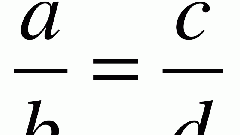You will need
- Ability to perform basic mathematical operations.
Instruction
1
From the definition of an arithmetic progression follows the following relationship between the neighboring members of the arithmetic progression, An+1=An+d, for example, A5=6 and d=2, then A6=A5+d=6+2=8.
2
If you know the first term (A1) and difference (d) arithmetic progression, you can find any of its members, using the formula n-th term of an arithmetic progression (An): An=A1+d(n-1). For example, let A1=2, d=5. Find, A5 and A10. A5=A1+d(5-1)=2+5(5-1)=2+5*4=2+20=22, and A10=A1+d(10-1)=2+5(10-1)=2+5*9=2+45=47.
3
Using the preceding formula to find the first member of an arithmetic progression. Then A1 will be the formula A1=An-d(n-1), that is, if we assume that A6=27 and d=3, A1=27-3(6-1)=27-3*5=27-15=12.
4
To find the difference (step) of an arithmetic progression, you need to know first and n-th member of the arithmetic progression, knowing them, the difference of the arithmetic progression is given by d=(An-A1)/(n-1). For example, A7=46, A1=4, then d=(46-4)/(7-1)=42/6=7. If d>0, then the progression is called increasing if d<0 - decreasing.
5
The sum of the first n terms of an arithmetic progression can be found by the following formula. Sn=(A1+An)n/2, where Sn - sum of n terms of an arithmetic progression, A1, An - 1-th and n-th member of the arithmetic progression respectively. We use the data from the previous example, then Sn=(4+46)7/2=50*7/2=350/2=175.
6
If the n-th member of the arithmetic progression is unknown, but known to step the arithmetic progression and the number of the n-th term, then to find the sum of arithmetic progression, you can use the formula Sn=(2A1+(n-1)dn)/2. For example, A1=5, n=15, d=3, then Sn=(2*5+(15-1)*3*15)/2=(10+14*45)/2=(10+630)/2=640/2=320.
Note
Any member of an arithmetic progression, starting with the second is the average of the previous and next member progression: An=(An-1+An+1)/2.





